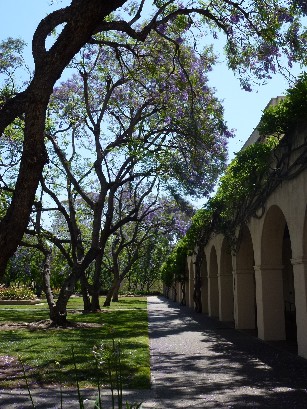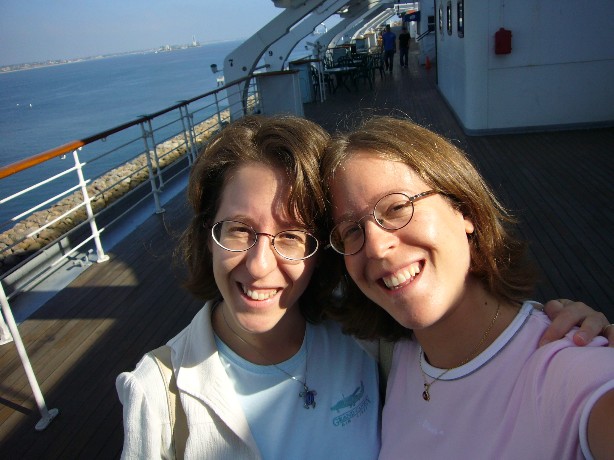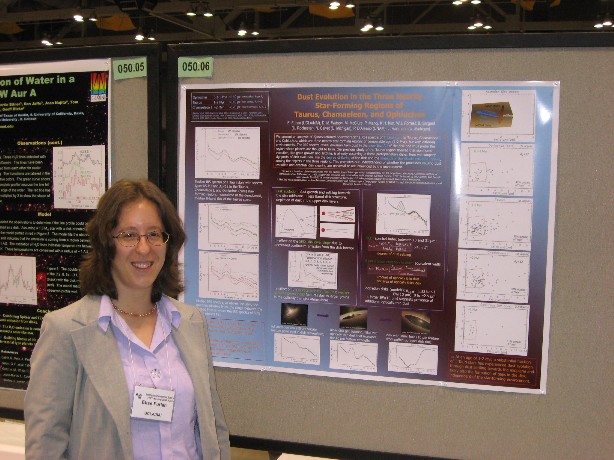Before that, I was an NOAO Postdoctoral Resarch Associate for 2 1/2 years, but visiting at IPAC. I was working under Lori Allen at NOAO and with Babar Ali at IPAC as a member of the Herschel Orion Protostar Survey (HOPS) team, which aims at understanding protostellar evolution by studying a large sample of protostars in the Orion star-forming region.
I was a Spitzer Fellow at the Jet Propulsion Laboratory from 2008 to 2011, working under Michael Werner on mid-infrared spectra of T Tauri stars, which was a continuation of my research as both a graduate student at Cornell University and as a NASA Postdoctoral Fellow at the NASA Astrobiology Institute at UCLA, where I worked from March 2006 to May 2008.
My Research Interests:
I am interested in the evolution of circumstellar material, how the primordial gas and dust are distributed and processed and eventually dissipated and built into planetary systems. The spectra I have been studying mainly tell us about the distribution and properties of the dust; for example, we can tell whether dust grains have grown and started settling towards the disk midplane, which are processes thought to be the first stages on the long road towards planet formation. Mid- and far-infrared data on protostellar objects reveal information on the huge envelopes around these objects, like their density, temperature distribution, and structure, and the initial conditions of planet-forming disks embedded within.
My interests also include extrasolar planets, their demographics
and characterization. It is very exciting that we now know of
a few thousand of extrasolar planets, and we can try to understand
how the planet formation process can give rise to the variety of
systems we observe.


My Background and Family:As to my background, I am originally from the very north of Italy, a small region called South Tyrol in the middle of the Alps where people speak German in addition to Italian. I went to the University of Innsbruck in Austria to get my undergraduate degree in astronomy (working on the topic of planetary nebulae interacting with the interstellar medium). Afterwards I went to Cornell University in Ithaca, NY, to pursue graduate studies in astronomy. I did my thesis work on circumstellar disks and envelopes of young stellar objects in the Taurus star-forming region studied with the Infrared Spectrograph on the Spitzer Space Telescope.


I have a twin sister who is a pediatrician at the University Medical Center in Ulm, Germany. She is married to her soulmate, also an MD. In December 2014 they had a son, and they are now a very happy family.
 My husband, Keven Uchida, works at JPL; he has an exciting, but also very demanding job "flying" spacecraft around Mars and Saturn. We feel fortunate to be both involved in space exploration, exploring our neighborhood in the solar system and also the space beyond, where billions of stars and likely billions of planets form our home, the Galaxy (which is just one of hundreds of billions in the universe...). I hope that decades and centuries from now future generations will look back at this time and remember our pioneering work.
My husband, Keven Uchida, works at JPL; he has an exciting, but also very demanding job "flying" spacecraft around Mars and Saturn. We feel fortunate to be both involved in space exploration, exploring our neighborhood in the solar system and also the space beyond, where billions of stars and likely billions of planets form our home, the Galaxy (which is just one of hundreds of billions in the universe...). I hope that decades and centuries from now future generations will look back at this time and remember our pioneering work.

